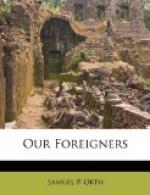Over 338,000 Magyars immigrated to the United States during the decade ending 1910. These brilliant and masterful folk are a Mongoloid blend that swept from the steppes of Asia across eastern Europe a thousand years ago. As the wave receded, the Magyars remained dominant in beautiful and fertile Hungary, where their aggressive nationalism still brings them into constant rivalry on the one hand with the Germans of Austria and on the other with the Slavs of Hungary. The immigrants to America are largely recruited from the peasantry. They almost invariably seek the cities, where the Magyar neighborhoods can be easily distinguished by their scrupulously neat housekeeping, the flower beds, the little patches of well-swept grass, the clean children, and the robust and tidy women. Among them is less illiteracy than in any other group from eastern and southern Europe, excepting the Finns, who are their ethnic brothers. As a rule they own their own homes. They learn the English language quickly but unfortunately acquire with it many American vices. Drinking and carousing are responsible for their many crimes of personal violence. They are otherwise a sociable, happy people, and the cafes kept by Hungarians are islands of social jollity in the desert of urban strife.
In bold contrast to these ardent devotees of nationalism, the Jew, the man of no country and of all countries, is an American immigrant still to be considered. By force of circumstance he became a city dweller; he came from the European city; he remained in the American city; and all attempts to colonize Jews on the land have failed. The doors of this country have always been open to him. At the time of the Revolution several thousand Jews dwelt in American towns. By 1850 the number had increased to 50,000 and by the time of the Civil War to 150,000. The persecutions of Czar Alexander III in the eighties swelled the number to over 400,000, and the political reactions of the nineties added over one million. Today at least one fifth of the ten million Jews in the world live in American cities.
The first to seek a new Zion in this land were the Spanish-Portuguese Jews, who came as early as 1655. They remain a select aristocracy among their race, clinging to certain ritualistic characteristics and retaining much of the pride which their long contact with the Spaniard has engendered. They are found almost exclusively in the eastern cities, as successful bankers, merchants, and professional men. There next came on the wave of the great German immigration the German Jews. They are to be found in every city, large and small, engaged in mercantile pursuits, especially in the drygoods and the clothing business. Nearly all of the prominent Jews in America have come from this stock—the great bankers, financiers, lawyers, merchants, rabbis, scholars, and public men. It was, indeed, from their broad-minded scholars that there originated the widespread liberal Judaism which has become a potent ethical force in our great cities.




